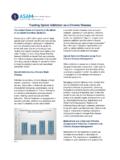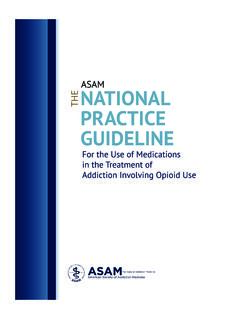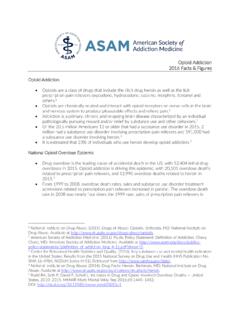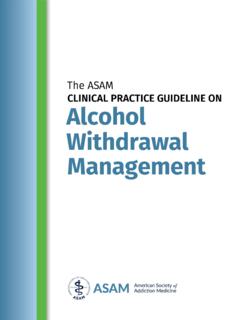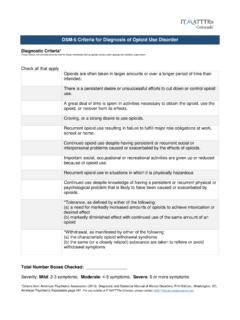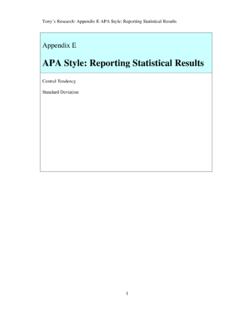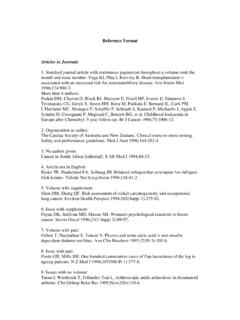Transcription of ASAM Guide to Style
1 ASAM Guide to Style November 2014 Table of Contents I. II. ASAM Style A quick overview of common usage questions and formats III. Become an 3 Become an ace with these simple tips IV. ASAM Identity and Logo placement, visual guidelines, and fonts V. Business Letters, Facsimiles and 7 Business correspondence guidelines and templates VI. Society Reports, Policy Documents, and Guidelines and document template VII. PowerPoint Presentation Template VIII. Board Reports & Status Report and Decision Memo Templates IX. Punctuation, Grammar and A brief overview of grammatical construction, alphabetic by subject Appendix A: 17 Appendix B: Punctuation, Grammar and Style 18 Appendix C: Sample AMA Appendix D: Glossary of Addiction Appendix E: Notes on The ASAM Note On Social 1 I. Introduction Style is paramount to the way we as humans communicate. Simply put, Style sets the tone of all communications and determines whether or not and how a message is conveyed and received.
2 This Style Guide aims to define a unified and consistent manner for ASAM to speak with its members and the public. The goals are trifold: To develop, enhance and oversee communications by keeping the voice and brand of ASAM consistent over all mediums To maintain a professional image that communicates a progressive, high-quality membership association To strengthen the voice of ASAM and our members Achieving these goals depends on each staff having an intimate familiarity with the association s Style and a willingness to take an active role in ensuring that each communication, whether it is a letter to a government official, a tweet, or a webpage, follows the guidelines described herein. ASAM Style is built from the AMA Manual of Style , A Guide for Editors and Authors, 10th Edition; this book, along with the ASAM Guide to Style , will serve as the authority for all written, electronic, and published communication. William Strunk and White s The Elements of Style can also be used a reference and a copy is available in the ASAM Publications Department.
3 The ASAM Guide to Style covers a wide range of topics from the brand identity to nitty-gritty grammatical tricks. The most salient points are outlined on the following page, ASAM Style Cheat Sheet. Finally, this Guide should be considered a living document and your participation is central to keeping the Style of the organization consistent and up-to-date. As questions of Style arise that are unanswered by this Guide , refer first to the American Medical Association (AMA) Manual of Style and second to the ASAM Publications Department. 7/23/2012 II. ASAM Style Cheat Sheet A quick overview of common usage questions and formats All grammar rules listed here are derived from the AMA Manual of Style . Exceptions are notated with an asterisk (*). A copy is stored in the ASAM library reference section. For staff not in the Chevy Chase office, please contact the Publications Department with questions. Abbreviations: Academic degrees are abbreviated in bylines and text when used with the full name of a person, and degrees below the master s level are generally not listed.
4 Generally, days of the week and months are not abbreviated except in tables. Do not use periods or commas with N, S, E, W or their combinations. At first mention, the name of a state, territory, possession, province, or country should be spelled out when it follows the name of a city (ie, London, England; Ontario, Canada; and Chicago, Illinois). Acronyms: The acronym ASAM is never preceded by the. ASAM is not pronounced by separating the letters ( NOT: A-S-A-M), but rather as ay-sam. Except in special circumstances, spell out acronyms at their first occurrence and include the acronym in parentheses at that citation. (see Appendix A for complete list of common acronyms) Font: In electronic media, processing letters, memos and faxes, ASAM s default font is Arial (size 11). Do not use expanded, condensed, or rounded versions. Avoid these terms: Addict, addictions (addiction is never plural), addictive (as a noun addictive disorders , alcoholic (as a noun- "the alcoholic failed to adhere to the treatment plan"), painkiller, and narcotic.)
5 Note on ie and eg: ie introduces a clarification, and can be remembered as in essence, whereas eg introduces an example. I like card games (ie, bridge and crazy eights). I recommend our publications (eg, PPC-2R and ASAM Weekly). The first sentence uses ie provides clarification and tells the reader which card games the subject prefers. The second sentence provides some, but not all, examples of our publications. Even more is an abbreviation for id est or Latin for it is ; is an abbreviation for egregious exemplum Latin for an excellent example. Periods: Never use periods with honorifics, scientific terms or abbreviations. David Mee-Lee, MD Jane Doe, PhD 7/23/2012 Never use periods with the professional credential FASAM (Fellow American Society of Addiction Medicine). Always put FASAM last in a series of honorifics following a name. Non-FASAM titles should be put before FASAM in alphabetical order.
6 J. Ramsay Farah, MD, MPH, FAAP, FACMP, FASAM Use No. for number and St. when it is part of a person s name, although no period is used with St in a city name, eg, St Louis, Missouri). Do not use periods for eg or ie. The conference was held in St Louis, Missouri. Our staff member Martin St. Claire attended the meeting. DO use periods after titles (Dr., Ms., Mr.).* Dr. Michaels but George Michaels, MD DO use periods for middle and beginning initials. Dr. George C. Michaels J. Murphy Smith At the end of any sentence (or question), be sure to leave only one space after your final punctuation. Numbers : Numbers one through and including ten are spelled out. Numbers 11 and higher should be written as numerals. However, Style should be consistent within a sentence based upon the first number that occurs. (The five people ran twelve miles total.
7 OR The 12 people ran 5 miles total.) A number at the beginning of a sentence should be spelled out. Twelve people attended the staff retreat. Opioid/Opiate: The term opiate describes any of the sedative opioid alkaloids found as natural products in the opium poppy plant. Opioid is the larger umbrella term that describes both opiates and synthetic substances that incorporate ingredients other than those naturally occurring in the poppy plant. Time*: Use am and pm (no punctuation) to designate times. We have scheduled the conference call for 3 pm on Monday. Treatment of Common Terms Do not capitalize addiction medicine when referring to the specialty of addiction medicine. denotes a break with AMA Manual of Style 7/23/2012 Use email, not E-mail or E-Mail. Use email addresses exactly as given.* Example: not Express health care as 2 words. It is not necessary to hyphenate health care in its adjectival form.
8 Capitalize Internet, the World Wide Web, and when it stands alone Web, but lowercase website.* Common Titles*: Always use the term ABAM Diplomate when listing with honorifics. Shortening to DABAM is incorrect. 7/23/2012 III. Become an Ace Become an ace with these simple tips Tips for Communicating with ASAM Members Construction Do not use shorthand (eg, exam for examination, preemie for premature infant, prepped for prepared). Euphemisms sometimes are not clear and should be avoided: The patient died is preferred to The patient succumbed or expired ; the same holds true for killed vs sacrificed (in discussion of animal subjects). Patients aren t put on medication, they re treated with medication. Also, patients aren t placed on ventilators, they re given ventilatory assistance. ASAM members are physicians not doctors. This distinction is important as more PhD-trained professionals (who are doctors) enter the workforce. Don t refer to physicians as providers.
9 If you are referring to physicians and non-physicians together, you can use the term providers. The term medication assisted treatment can be written without hyphens. ASAM for the actual name of the organization, when it s a housed and editable item on our website, shorten it. For news releases and PDFs we leave online, spell it out. Listing doctors when creating a list of doctors, use the shortened Drs. before listing their names. Wrong: Dr. Goldsmith, Dr. Jarvis and Dr. Gastfriend Right: Drs. Goldsmith, Jarvis and Gastfriend Double and triple-check terminology when addressing members! Wrong: Physician s Assistant/Physician s Assistants Right: Physician Assistant or Physician Assistants Terms Client [PPC, 2001] The terms "client" and "patient" sometimes are used interchangeably, although staff in medical settings more commonly refer to "patients," while individuals who receive services in non-medical outpatient settings often are referred to as "clients.
10 " Surgeons perform operations or surgical procedures, not surgeries. Tips for Successful Communication Begin with your conclusion. If you knew readers would only read the first sentence or the first paragraph of your report and nothing else, what would it say? Use the fewest words necessary. Eliminate unnecessary words to streamline your sentences. Avoid run-on sentences. If a sentence is more than three lines long, it probably needs to be broken into two separate sentences. Use the active voice. The committee developed the access policy statement, vs. The policy statement on access was developed by the committee. When posting a news item to the ASAM website, be sure it reflects the full date (not, On Wednesday, ASAM ). 7/23/2012 Learn From the Expert Vigorous writing is concise. A sentence should contain no unnecessary words, a paragraph no unnecessary sentences, for the same reason that a drawing should have no unnecessary lines and a machine no unnecessary parts.
